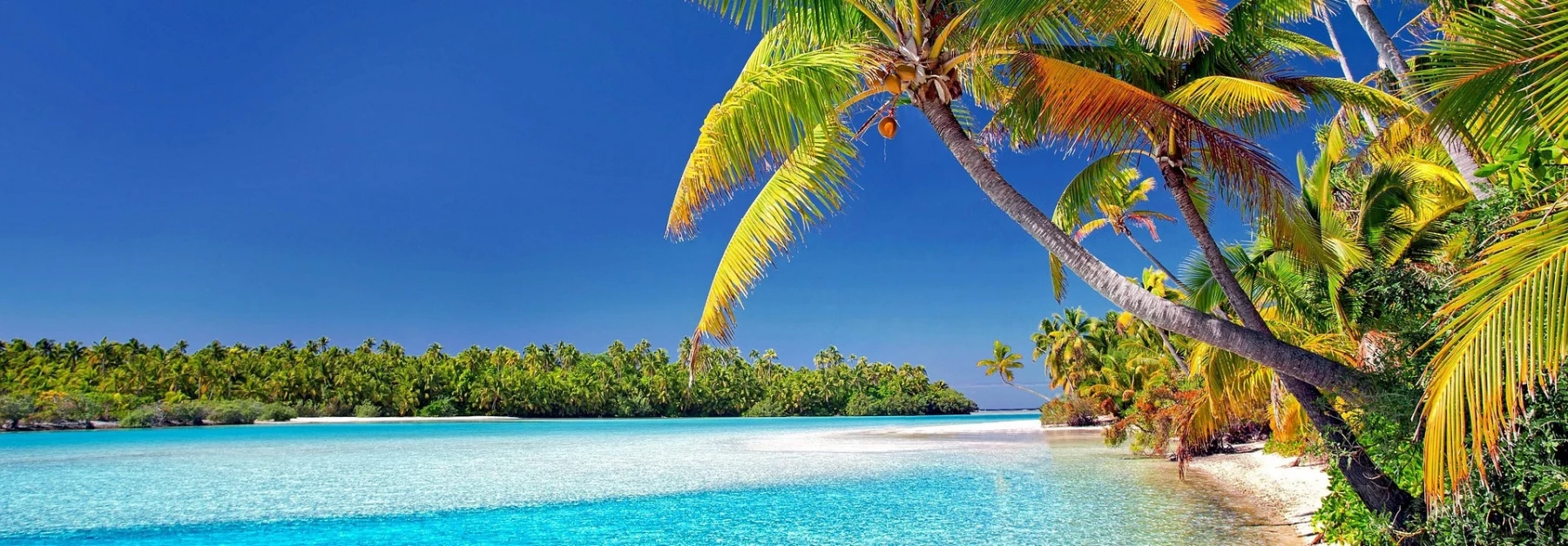To visit - Cook islands
The Cook Islands are a group of islands in the South Pacific that are associated with New Zealand. Here are some key facts about the Cook Islands:
-
Geographical Location: The Cook Islands are situated in the South Pacific Ocean, between French Polynesia and Samoa. They are spread over a vast oceanic expanse.
-
Political Status: The Cook Islands are a self-governing state in free association with New Zealand. This means that they are self-governing but have a special relationship with New Zealand in terms of defense and certain government services.
-
Capital: Avarua, located on the island of Rarotonga, is the political and economic capital of the Cook Islands.
-
Population: The population of the Cook Islands is relatively small, consisting mainly of Polynesians.
-
Economy: Tourism is a significant source of income for the Cook Islands. Visitors are attracted to the pristine beaches, coral reefs, and Polynesian culture. Agriculture, fishing, and crafts also contribute to the local economy.
-
Languages: The official languages of the Cook Islands are English and Cook Islands Māori (also known as Rarotongan).
-
Culture: The culture of the Cook Islands is steeped in Polynesian traditions. Dance, music, crafts, and traditional festivities play a crucial role in the cultural life of these islands.
-
Environment: The Cook Islands are renowned for their natural beauty, featuring turquoise lagoons, white sandy beaches, and abundant marine life. Environmental preservation has become an increasing concern to ensure the sustainability of tourism and the protection of biodiversity.
The Cook Islands are a popular destination for travelers seeking a tranquil tropical getaway while experiencing the richness of Polynesian culture.
Explore the 11 must-do activities in the Cook Islands :
Summary
- To visit
-
- 1 - Rarotonga
- 2 - Aitutaki
- 3 - Atiu
- 4 - Mitiaro
- 5 - Mauke
- 6 - Cook Islands Museum in Avarua
- 7 - Hike to the top of Mount Te Rua Manga (The Needle)
- 8 - Moturakau
- 9 - Catamaran cruise
- 10 - Taste delicious Polynesian cuisine
- 11 - Whale watching
- Cook Islands - Where to Stay?
- Cook Islands - How to get around?
- Cook Islands - Best period
1 - Rarotonga
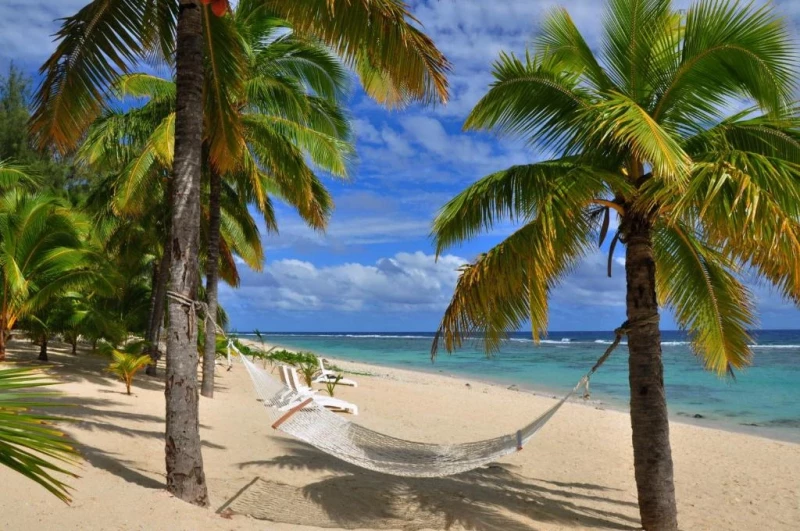
Rarotonga is the largest island and the capital of the Cook Islands. Located in the South Pacific, Rarotonga is a popular destination due to its natural beauty, stunning beaches, cultural activities, and laid-back atmosphere. Here are some of the attractions and activities to explore in Rarotonga:
-
Circular Road (Ara Tapu): The road that circles the island offers spectacular panoramic views of the interior mountains, white sandy beaches, and turquoise lagoon. You can explore Rarotonga by scooter, bike, or car.
-
Te Rua Manga (The Needle): This iconic mountain offers an excellent hike with panoramic views of the island. The hike may take a few hours, but the view from the summit is worth it.
-
Muri Beach: This beach is one of Rarotonga's most famous, with its calm lagoon and crystal-clear waters. It's an ideal spot for swimming, snorkeling, and water sports.
-
Avarua: The capital of the Cook Islands, Avarua is the economic and cultural center of Rarotonga. Explore the local market, craft shops, and visit the historic coral church.
-
Botanicka: A botanical garden located on the northwest coast of the island, showcasing a variety of tropical plants, fruits, and flowers.
-
Cultural Ceremonies: Attend traditional Polynesian dance shows and participate in cultural events to experience the living heritage of the Cook Islands.
-
Lagoonarium: A marine park located on the island, offering the opportunity to swim with tropical fish, rays, and sea turtles.
-
Cross Island Trek: For hiking enthusiasts, the trek through the island's interior provides an immersive experience in tropical jungle and the discovery of waterfalls.
-
Scuba Diving and Snorkeling: Explore colorful coral reefs and abundant marine life in the warm waters of the lagoon.
-
Muri Night Market: Usually held on Tuesday, Wednesday, Thursday, and Sunday evenings, the night market at Muri Beach provides an excellent opportunity to taste local cuisine, discover crafts, and enjoy music and dance.
Whether you're interested in adventure, beach relaxation, or exploring local culture, Rarotonga offers a variety of activities for every taste.
 Our tips for getting the most out of your experience.
Our tips for getting the most out of your experience.
Visiting Rarotonga can be an incredible experience, and to make the most of your trip, here are some helpful tips:
-
Rent a Scooter or Bicycle: The best way to explore Rarotonga is often by renting scooters or bicycles. This allows you to easily get around, explore the more remote corners of the island, and enjoy the scenery.
-
Local Market: Avarua Market is a must-visit. Explore it to taste fresh tropical fruits, buy local crafts, and immerse yourself in the daily life of the island.
-
Hike to Te Rua Manga: If you enjoy hiking, don't miss the ascent to the top of Te Rua Manga, also known as "The Needle." The panoramic views from the summit are spectacular.
-
Spend Time on the Beaches: Rarotonga boasts beautiful beaches. Muri Beach is particularly popular for its calm waters and water activities. Don't forget to explore other beaches such as Titikaveka and Aroa.
-
Snorkeling and Scuba Diving: Explore the beautiful coral reefs surrounding the island. Bring your own snorkeling gear or participate in organized diving excursions.
-
Attend Cultural Shows: Enjoy cultural evenings offered by hotels or local entertainment centers to experience Polynesian music, dance, and traditions.
-
Taste Local Cuisine: Don't miss the opportunity to try local dishes such as fresh fish, taro, ika mata (a kind of ceviche), and tropical fruits. Local restaurants and food stalls offer a delicious culinary experience.
-
Community Events: Inquire about local community events that might take place during your stay. It's a great way to meet locals and participate in the island's life.
-
Respect the Environment: The Cook Islands are known for their preserved natural beauty. Respect the environment by following eco-friendly practices and avoiding leaving litter on beaches or in nature.
-
Explore Night Markets: In addition to Avarua Market, explore night markets at Muri Beach to experience the lively atmosphere, taste local dishes, and purchase handmade souvenirs.
Remember that Rarotonga is a laid-back destination, so take the time to relax, explore at your own pace, and appreciate the natural beauty and culture of the island.
2 - Aitutaki
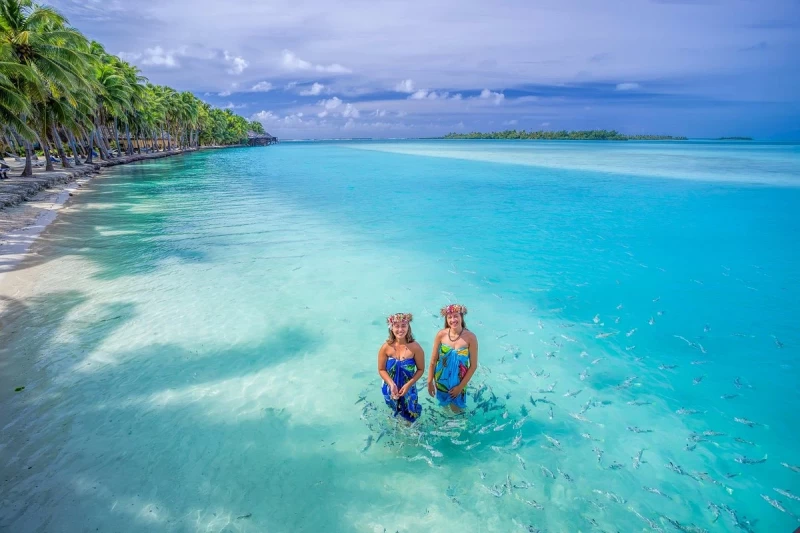
Aitutaki is a stunning atoll in the Cook Islands, known for its breathtaking turquoise lagoon, coral reefs, and pristine beaches. Here are some tips for visiting Aitutaki:
-
Lagoon Cruise: One of the highlights of Aitutaki is a lagoon cruise. Join a boat tour to explore the crystal-clear waters, visit small islets, and snorkel in the vibrant coral gardens. Some cruises also include a visit to One Foot Island.
-
One Foot Island: This small islet within the Aitutaki lagoon is famous for its picturesque beach and the opportunity to get your passport stamped at the One Foot Island Post Office.
-
Snorkeling and Diving: Aitutaki offers fantastic opportunities for snorkeling and scuba diving. Explore the colorful coral formations and encounter diverse marine life, including tropical fish and rays.
-
Hiking: While Aitutaki is known for its water activities, you can also explore the island on foot. Hike to the top of Maunga Pu, the highest point on the island, for panoramic views of the lagoon and surrounding islets.
-
Bike Rentals: Rent a bicycle to explore Aitutaki at your own pace. Many accommodations offer bike rentals, allowing you to visit local villages, beaches, and scenic spots.
-
Cultural Experiences: Immerse yourself in the local culture by attending traditional dance performances, visiting historical sites, and interacting with the friendly Cook Islands locals.
-
Sunset Cruises: Enjoy the breathtaking Aitutaki sunset by joining a sunset cruise. This is a romantic and picturesque way to end your day on the island.
-
Fresh Seafood: Indulge in delicious seafood at local restaurants. Aitutaki is known for its fresh catches, including tuna, mahi-mahi, and lobster.
-
Tropical Fruit Tasting: Sample a variety of tropical fruits that thrive on the island, such as pawpaw, passion fruit, and coconut. Local markets are great places to experience the island's flavors.
-
Relax on the Beach: With its white sandy beaches and tranquil atmosphere, Aitutaki is the perfect place to unwind. Spend lazy days on the beach, swim in the clear waters, and soak up the sun.
Remember to check local events and activities, as the offerings can vary based on the time of year and community events. Aitutaki's natural beauty and warm hospitality make it a memorable destination for travelers seeking a tropical paradise.
 Our tips for getting the most out of your experience.
Our tips for getting the most out of your experience.
Visiting Aitutaki can be an unforgettable experience, and to make the most of your time on this beautiful island, here are some tips:
-
Lagoon Cruise: Opt for a lagoon cruise in Aitutaki to explore its crystal-clear waters, deserted islets, and exceptional snorkeling spots. Make sure to choose an excursion that includes memorable stops like One Foot Island.
-
One Foot Island: Don't miss the opportunity to visit One Foot Island, famous for its white sandy beach and the post office where you can stamp your passport. It's an ideal place to relax and soak in the paradise.
-
Snorkeling and Diving: Bring your snorkeling gear or join diving excursions to discover Aitutaki's exceptional marine life in its coral reefs. Some accommodations may also provide the necessary equipment.
-
Hiking to Maunga Pu: For panoramic views of the island, take the hiking trail to the top of Maunga Pu. It's an excellent activity for hiking enthusiasts.
-
Bike or Scooter Rentals: Explore the island at your own pace by renting a bike or scooter. It's an ideal way to visit local villages, beaches, and attractions at your leisure.
-
Tasting Local Fruits: Experience the freshness of local tropical fruits such as papaya, guava, mango, and coconut. Local markets are good places to buy fresh produce.
-
Attend Cultural Shows: Inquire about Polynesian dance shows or cultural events that may take place during your stay. It's an opportunity to immerse yourself in the rich culture of the Cook Islands.
-
Sunset at Ootu Beach: Enjoy a spectacular sunset from Ootu Beach. Bring a blanket, sit on the sand, and relax while admiring the warm colors of the sky.
-
Meet the Locals: Interact with Aitutaki locals to learn more about their way of life, traditions, and local stories. Locals are typically friendly and welcoming.
-
Respect the Environment: Aitutaki is a pristine and beautiful place. Respect the environment by avoiding littering, following designated trails during hikes, and respecting marine life during water activities.
When planning your stay in Aitutaki, be sure to check the weather conditions and plan your activities based on any local events that could enhance your experience. Enjoy every moment on this paradise island.
3 - Atiu
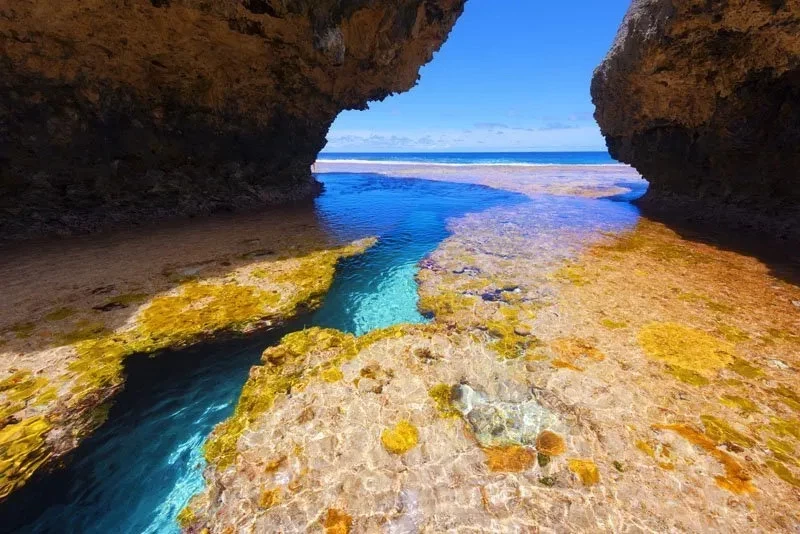
Atiu, in the Cook Islands, offers a unique and authentic travel experience, combining lush nature, mysterious caves, and traditional Polynesian culture. Here are some elements you could highlight in a travel theme dedicated to Atiu:
-
Cave Exploration: Invite travelers to explore Atiu's impressive limestone caves, such as the famous Anatakitaki Cave. Emphasize the unique stalactite and stalagmite formations, offering a one-of-a-kind discovery experience.
-
Hiking through Nature: Encourage visitors to traverse Atiu's hiking trails, discovering lush nature, tropical forests, and makatea landscapes. Nature enthusiasts can appreciate the island's biodiversity and tranquility.
-
Meeting the Local Culture: Highlight the richness of Polynesian culture through visits to marae, ancient ceremonial sites. Travelers can participate in cultural events, discover local art, music, and dance, and immerse themselves in the daily life of the population.
-
Bird Watching: Showcase Atiu's biodiversity by emphasizing bird watching, especially the Kopeka, a unique species that nests in the island's caves.
-
Diving and Snorkeling: Suggest aquatic activities along the coral reef surrounding the island. Atiu offers diving and snorkeling opportunities to explore the colorful and diverse marine life.
-
Authentic Stays: Encourage travelers to stay in local accommodations for an authentic and warm experience. Small pensions and guesthouses often provide insights into daily life in Atiu.
-
Local Cuisine: Highlight the delicious local cuisine, based on fresh produce and Polynesian flavors. Visitors can taste traditional dishes and explore the local gastronomy.
-
Responsible Ecotourism: Emphasize the importance of preserving Atiu's fragile ecosystem by encouraging responsible travel practices, such as waste management and biodiversity conservation.
By incorporating these elements, you can create a captivating travel theme that showcases the natural beauty, rich culture, and immersive experience that Atiu has to offer to travelers.
 Our tips for getting the most out of your experience.
Our tips for getting the most out of your experience.
Visiting Atiu can be a unique and rewarding experience. Here are some tips to make the most of your trip to Atiu:
-
Advance Planning: Atiu is less touristy than some other destinations, so advance planning is essential. Make sure to research available flights, accommodation options, and the activities you want to do.
-
Local Accommodations: Opt for local accommodations such as guesthouses or homestays. This not only provides a more authentic experience but also supports the local community.
-
Explore the Caves: Don't miss the limestone caves in Atiu. Consider joining guided tours to learn more about the geology and history of these natural formations.
-
Hiking: Explore hiking trails to discover the lush nature of the island. Make sure to wear appropriate footwear as some trails may be rocky.
-
Cultural Encounters: Visit local marae to discover Atiu's rich cultural history. Attend cultural events, traditional dances, and interact with the local population.
-
Bird Watching: If you're passionate about ornithology, seize the opportunity to observe Atiu's unique birds, especially the Kopeka. Bring binoculars for a better experience.
-
Diving and Snorkeling: Explore the crystal-clear waters surrounding the island. Bring your diving gear or take advantage of snorkeling opportunities to discover the colorful marine life.
-
Environmental Respect: Atiu is a pristine destination, so make sure to respect the environment. Follow sustainable tourism principles, avoid leaving waste, and respect the local flora and fauna.
-
Adapt to Island Life: Be prepared to adapt to the island's pace of life. The Cook Islands are known for their laid-back atmosphere, so take the time to relax and enjoy Atiu's peaceful environment.
-
Connect with Locals: Interact with the locals. Residents are often warm and welcoming, and engaging with them can enrich your travel experience.
Keep in mind that these tips may evolve based on local changes, so it's always good to check the latest information before your trip. Enjoy your stay in Atiu!
4 - Mitiaro
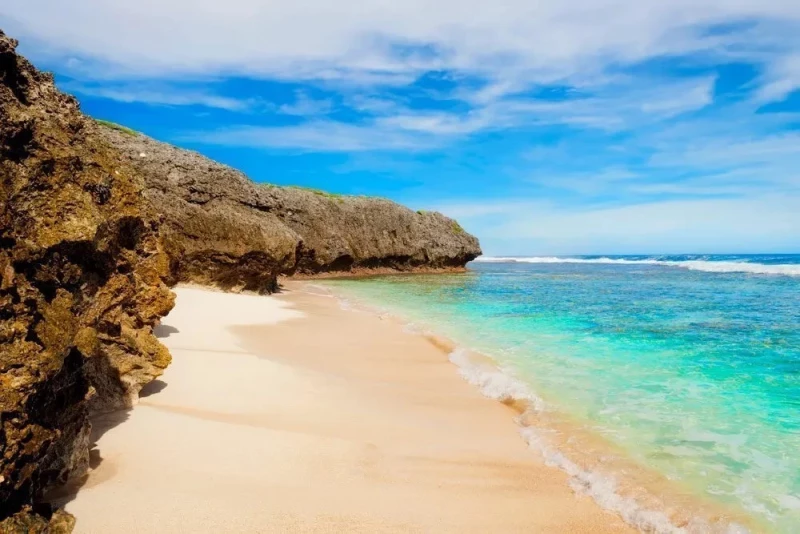
Mitiaro is another one of the Cook Islands, located in the South Pacific Ocean. It is one of the Southern Group islands and is situated about 142 kilometers southeast of Rarotonga, the capital of the Cook Islands. Here are some key points about Mitiaro:
-
Geography: Mitiaro is a raised coral atoll with a central plateau surrounded by a makatea (raised coral limestone) belt. The island has a circular shape and a lagoon in its center.
-
Culture and Traditions: Mitiaro, like other Cook Islands, has a rich Polynesian culture. Visitors have the opportunity to experience traditional dance, music, and arts. The locals are known for their friendliness and warm hospitality.
-
Nature and Environment: Mitiaro is known for its natural beauty, with lush landscapes, coconut plantations, and white sandy beaches. The island is surrounded by a coral reef, making it a suitable destination for snorkeling and diving.
-
Fishing: Fishing is a common activity on the island, and visitors may have the opportunity to experience traditional Cook Islands fishing methods or enjoy freshly caught seafood.
-
Marae and Historical Sites: Mitiaro has marae, which are traditional Polynesian ceremonial sites. These sites provide insights into the island's history and cultural practices.
-
Tropical Climate: Like the other Cook Islands, Mitiaro has a tropical climate, with warm temperatures throughout the year. The wetter season is generally from November to March.
-
Quiet and Relaxing Atmosphere: Mitiaro is known for its tranquil and laid-back atmosphere. It offers a peaceful escape for those seeking a more remote and less touristy destination.
As with any travel destination, it's advisable to check for the latest information and travel updates before planning a visit to Mitiaro, as circumstances may change.
 Our tips for getting the most out of your experience.
Our tips for getting the most out of your experience.
Visiting Mitiaro can provide a unique and authentic experience in the Cook Islands. Here are some tips to make the most of your trip to Mitiaro:
-
Advance Planning: Since Mitiaro is less touristy, advance planning is crucial. Check transportation options, accommodation, and available activities.
-
Local Accommodations: Opt for local accommodations such as guesthouses or hostels. This can offer a more authentic experience and provide closer contact with the local culture.
-
Exploration of Historical Sites: Visit marae and other historical sites to discover the island's history and culture. Some sites may require local guides for an enriching experience.
-
Nature Discovery: Explore Mitiaro's natural landscapes, including white sandy beaches, coconut plantations, and makatea areas. Renting bikes can be an excellent way to explore the island.
-
Interaction with Local People: Interact with the locals. Mitiaroans are often warm and welcoming. Learn some basic Maori words to facilitate communication.
-
Local Culinary Experience: Taste local cuisine, especially dishes made with fresh seafood. Local restaurants may offer unique culinary specialties.
-
Water Activities: Enjoy water activities such as snorkeling and fishing. Mitiaro's crystal-clear waters provide excellent visibility to explore marine life.
-
Environmental Respect: Contribute to the preservation of the island's fragile ecosystem. Avoid leaving waste, adhere to conservation guidelines, and participate in local ecological initiatives.
-
Relaxation: Embrace the island's peaceful pace of life. Take time to relax on the beaches, admire the landscapes, and appreciate the tranquility of Mitiaro.
-
Light Clothing and Sun Protection: Due to the tropical climate, wear light clothing and ensure you have adequate sun protection.
Remember that Mitiaro is a quiet destination, offering an immersion into island life. Respect the local culture and enjoy this authentic getaway in the Cook Islands. Before your trip, check the latest information and any local changes.
5 - Mauke
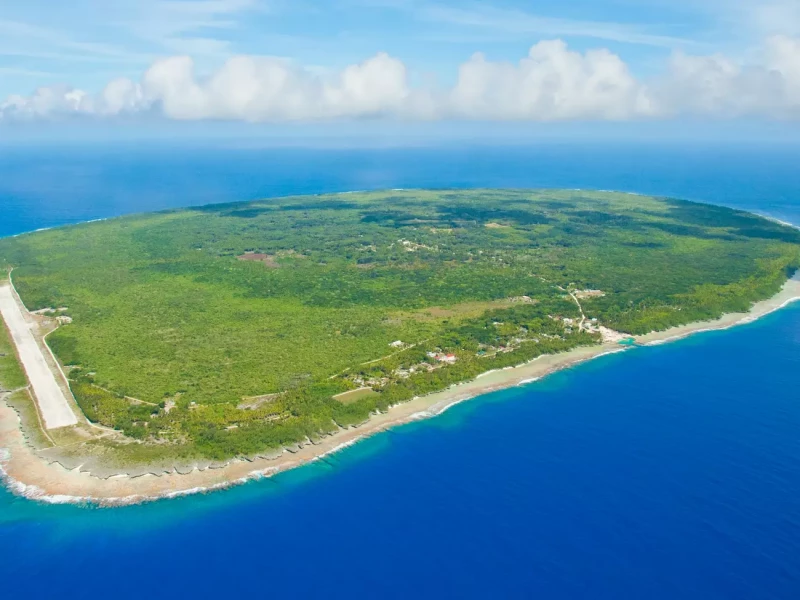
Mauke is one of the Cook Islands, a group of islands located in the South Pacific. Here is some information about Mauke:
-
Location: Mauke is situated in the central part of the Cook Islands, between the islands of Atiu and Mitiaro.
-
Geography: It is a small coral island, measuring approximately 18 kilometers in circumference. Mauke has gently rolling terrain and is surrounded by a coral reef.
-
Population: Mauke has a relatively small population. The inhabitants of the island are primarily engaged in agriculture, fishing, and other subsistence activities.
-
Culture: Like other islands in the Cook Islands, Mauke has a rich Polynesian culture. Dance, music, and traditional crafts are important elements of cultural life on the island.
-
History: Mauke has been inhabited by Polynesians for centuries. It was discovered by Europeans in the 18th century. The island was influenced by European colonization in the 19th century.
-
Tourism: Mauke receives fewer tourists compared to some other more well-known Cook Islands. However, for those seeking a quieter and more authentic experience, Mauke can offer a glimpse into traditional island life.
 Our tips for getting the most out of your experience.
Our tips for getting the most out of your experience.
Visiting Mauke can offer an authentic and tranquil experience, away from more frequented tourist destinations. Here are some tips to make the most of your visit to Mauke:
-
Trip Planning: Make sure to check flight schedules and plan your stay in advance, as Mauke may not have as many air connections as larger islands.
-
Accommodation: Mauke offers more modest and authentic accommodation options, including guesthouses run by locals. This can provide a deeper immersion into the local culture.
-
Transportation: On the island, you can get around by walking, biking, or renting a scooter. It's helpful to talk to locals for advice on the best ways to get around.
-
Local Activities: Participate in local activities, such as attending traditional dance performances, exploring local markets, or learning traditional arts and crafts.
-
Nature Exploration: Explore the peaceful beaches, farmlands, and natural areas of the island. Mauke is known for its tranquil landscapes and coral reefs.
-
Respect Local Customs: Be aware of and respectful towards local customs. Ask for permission before taking photos of people, and be mindful of local traditions and customs.
-
Meet Locals: Locals in Mauke are generally welcoming. Feel free to strike up conversations with them to learn more about the local culture and get tips on places to visit.
-
Local Cuisine: Taste the local food. Try traditional dishes cooked by locals and don't miss out on fresh tropical fruits from the region.
-
Diving and Snorkeling: Explore the coral reefs around the island by engaging in scuba diving or snorkeling. Mauke often offers less crowded but equally beautiful diving sites compared to other islands in the region.
-
Appreciate the Tranquility: Enjoy the quietness of Mauke. The island is less frequented by tourists, providing a more peaceful and authentic experience.
By following these tips, you can make the most of your visit to Mauke and have a memorable experience off the beaten path.
6 - Cook Islands Museum in Avarua
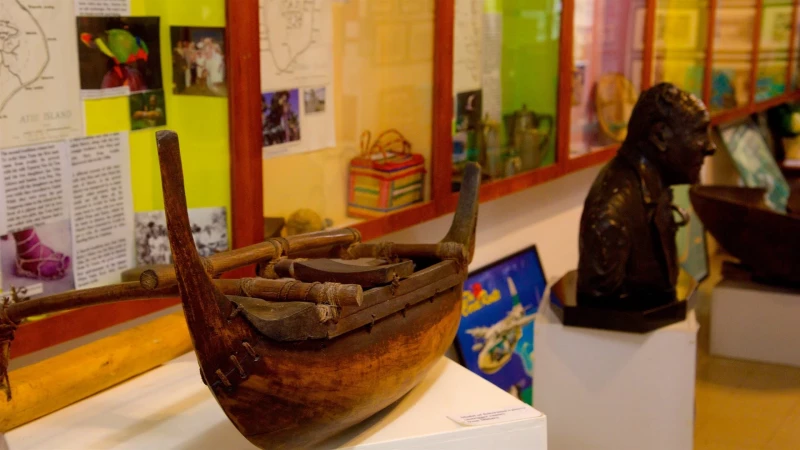
Explore the history and traditions of the Cook Islands through art and literature in a library and museum managed by warm-hearted locals. Far from the sun-soaked beaches and lush vegetation lies a haven of tranquility: the Cook Islands Library and Museum Society. What can you expect? The history of the region, consisting of about fifteen islands scattered across the Pacific Ocean. You can also borrow books for your beach afternoon.
Exhibits unveil the kitchen tools used for centuries in the Polynesian islands. The music exhibition highlights the famous ukulele and other lesser-known instruments: the pate (a wooden drum), the vivo (a wooden nasal flute), and the conch trumpet. Also on display are elegantly engraved weapons and a collection of Cook Islands seashells. Walls adorned with photos and diverse artworks by local artists showcase the region. A massive quilt called "tivaivai" hangs from the ceiling, its mosaic of 56,000 squares depicting an outrigger canoe sailing on the waves.
Photo exhibits include works by local artist Alistair Campbell and documentation by Bill Johnson on the 1974 visit of the British royal family. You'll appreciate the traditional ceremony of indigenous people adorned with green leaves, carrying important visitors on sedan chairs.
Volunteers manage this organization in two buildings aiming to preserve the history and culture of the Cook Islands. Initially a simple mobile library, it has become a permanent structure in the capital. You can examine the colorful mural outside the building depicting the past and present of the Cook Islands, featuring birds, fish, lizards, and a whale. You'll observe the sun, the ocean, sandy shores, primitive sailboats, and indigenous attire, all illustrated in a vibrant Polynesian artistic style.
You can purchase local books and, before leaving the island, donate the books you've already devoured to enrich the library's collection. To borrow books during your stay on the island, obtain a visitor subscription. The museum is open Monday to Saturday in the morning and Tuesday evenings. Admission is charged, and photography is prohibited.
7 - Hike to the top of Mount Te Rua Manga (The Needle)
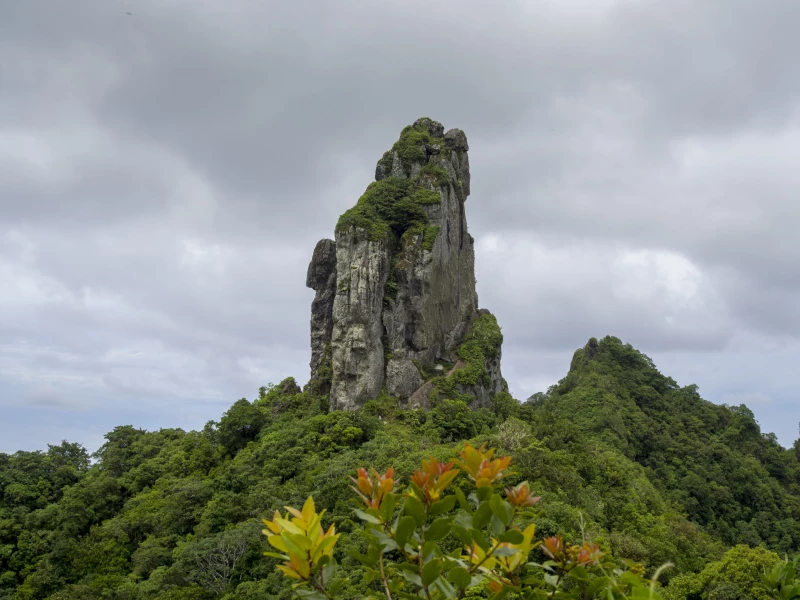
Te Rua Manga, also known as "The Needle," is a distinctive rock formation located in the center of Rarotonga, the largest island in the Cook Islands, a territory associated with New Zealand. This rock formation has a needle-like silhouette, hence the nickname "The Needle." The rock is a popular hiking destination, and many visitors hike to the summit to enjoy panoramic views of the island and its surroundings.
Rarotonga, where Te Rua Manga is situated, is known for its white sandy beaches, turquoise lagoons, and natural beauty. Hiking to Te Rua Manga is a popular outdoor activity, providing a unique experience and spectacular views of the island.
If you have specific questions about Te Rua Manga or if you need additional information, feel free to ask!
 Our tips for getting the most out of your experience.
Our tips for getting the most out of your experience.
Hiking to the summit of Mount Te Rua Manga, also known as "The Needle," can be a rewarding experience. Here are some tips to help you during your hike:
-
Physical Preparation: Ensure that you are physically fit for the hike. The trail can be steep in places, so having adequate fitness is important.
-
Wear Proper Footwear: Use comfortable and suitable hiking shoes. The trails can be rocky, so good traction is essential.
-
Bring Water and Snacks: Hiking can be demanding, so make sure to have enough water to stay hydrated. Energy snacks can also be helpful to replenish your energy levels.
-
Check Weather Conditions: Before you set out, check the weather conditions. Avoid hiking in extreme weather as it could make the trail more challenging and less safe.
-
Start Early: Begin your hike early in the day to avoid higher temperatures and to have enough time to reach the summit and descend safely.
-
Respect the Environment: Stick to designated trails to minimize your impact on the local ecosystem. Do not leave any waste, and respect the local flora and fauna.
-
Be Aware of Your Limits: If you are not accustomed to hiking or have health issues, be aware of your limits. Take breaks and pace yourself.
-
Inform Someone of Your Itinerary: Before you start, inform someone of your planned route and expected return time.
-
Bring a Map or Use Navigation Apps: Ensure you have a trail map or use navigation apps to help you stay on the right path.
-
Enjoy the Scenery: Take time to appreciate the natural beauty around you during your hike. The summit of Mount Te Rua Manga offers spectacular panoramic views.
By following these tips, you should be better prepared to enjoy your hike to the summit of Mount Te Rua Manga.
8 - Moturakau
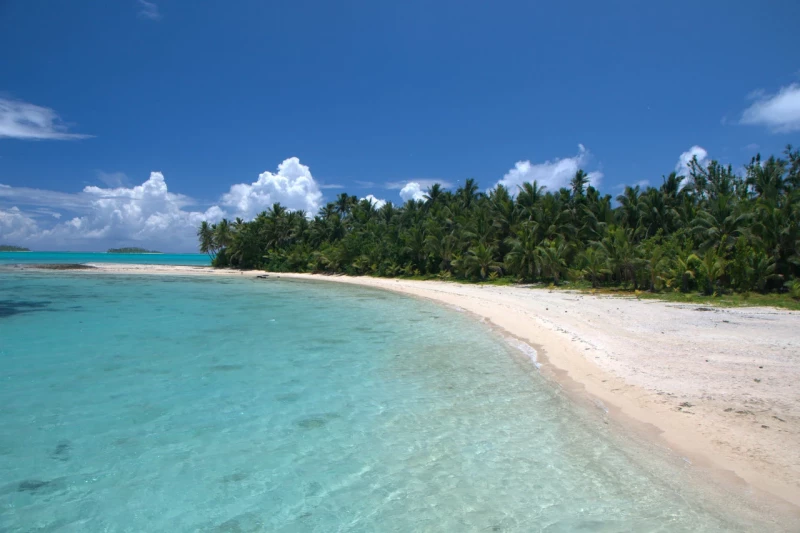
Moturakau is part of the Aitutaki atoll, which comprises 22 islands in the Cook Islands. Situated in the southeastern region of Aitutaki Lagoon, it lies between the larger islands of Rapota and Tekopua, approximately six kilometers southeast of the main Aitutaki island.
With dimensions of 460 meters in length and 120 meters in width, Moturakau served as a leper colony from the 1930s until 1967. In more recent times, it gained recognition as the location for the 'Sharks' during four seasons of the UK reality TV program Shipwrecked: Battle of the Islands and also hosted the 13th season of the Survivor franchise.
 Our tips for getting the most out of your experience.
Our tips for getting the most out of your experience.
Visiting Moturakau can be a unique and rewarding experience. Here are some tips to make the most of your visit:
-
Advance Planning: Ensure you have all the necessary information before your visit, including boat crossing schedules, weather conditions, and any local regulations.
-
Environmental Respect: Moturakau is a preserved natural area. Respect the local ecosystem by avoiding leaving any waste behind. Follow established rules to minimize your impact on the environment.
-
Essential Gear: Pack essential items such as comfortable shoes, weather-appropriate clothing, sunscreen, and drinking water. Ensure you have camera or video equipment if you wish to capture special moments.
-
Understanding Local Culture: If possible, learn about the history and culture of Moturakau before your visit. This will allow you to appreciate the location more and understand its historical significance, particularly as a former leper colony.
-
Sea Safety: If planning to cross by boat to reach Moturakau, ensure the mode of transportation is safe, and all safety measures are adhered to.
-
Water Activities: Explore the waters surrounding Moturakau by participating in water activities such as snorkeling, scuba diving, or boat excursions. Confirm that these activities are allowed in the area.
-
Respect Local Rules: Adhere to local rules and customs. If certain areas are off-limits, make sure to avoid them. Be respectful to local residents and other visitors.
-
Secure Exploration: If planning to walk or hike on the island, stick to designated trails and take necessary precautions for your safety.
By following these tips, you can enhance your experience when visiting Moturakau while contributing to the preservation of this natural environment.
9 - Catamaran cruise
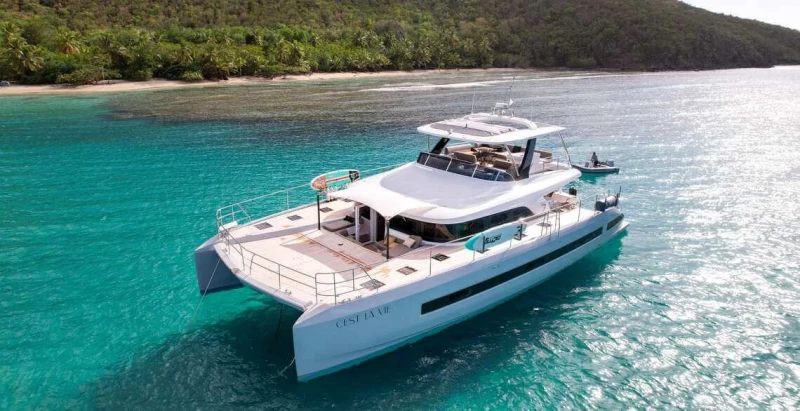
Embarking on a catamaran cruise in the Cook Islands can be an extraordinary adventure. Here are some tips to fully enjoy this experience:
-
Choose the Right Season: The Cook Islands have a tropical climate, but it's advisable to plan your cruise during the dry season for more stable weather conditions.
-
Select an Appealing Itinerary: The Cook Islands offer a plethora of stunning destinations. Choose an itinerary that includes stops at places you wish to explore, whether it's secluded beaches, coral reefs, or local villages.
-
Check Cruise Options: Various companies offer catamaran cruises in the Cook Islands. Compare options in terms of duration, itinerary, onboard services, and read reviews to choose the one that best fits your expectations.
-
Prepare for Snorkeling: The waters around the Cook Islands are ideal for snorkeling. Make sure to bring your gear, or check if the cruise provides rental equipment.
-
Sun Protection and Appropriate Attire: Due to the tropical climate, it's essential to bring adequate sun protection, hats, sunglasses, and lightweight clothing. Don't forget to pack swimwear as well.
-
Respect the Marine Environment: Be mindful of the fragile marine environment in the Cook Islands. Avoid littering in the water, adhere to marine conservation rules, and follow the crew's guidelines on the catamaran.
-
Participate in Offered Activities: Many catamaran cruises offer activities such as land excursions, beach dinners, and onboard entertainment. Take advantage of these opportunities to discover local culture and meet fellow travelers.
-
Book in Advance: Catamaran cruises can be popular, so make sure to book in advance to secure your spot, especially during peak tourist seasons.
By following these tips, you'll be ready to have an unforgettable experience during your catamaran cruise in the Cook Islands.
10 - Taste delicious Polynesian cuisine
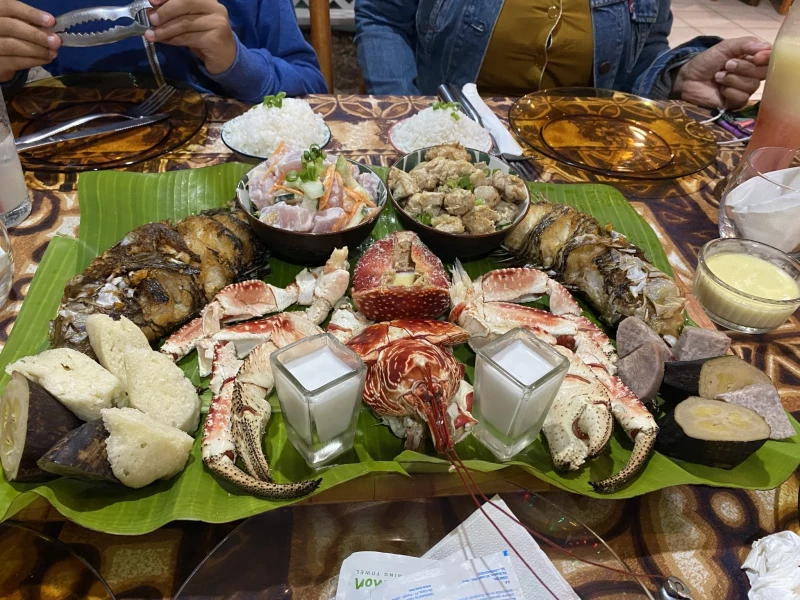
Dive into the delightful Polynesian cuisine in the Cook Islands for a truly memorable culinary experience. Here are some tips to savor the flavors of Polynesia:
-
Try Local Dishes: Explore the unique and diverse dishes that Polynesian cuisine has to offer. Don't miss out on specialties like ika mata (marinated raw fish), poisson cru (similar to ceviche), and rori (traditional coconut milk-based dishes).
-
Visit Local Markets: Immerse yourself in the vibrant local culture by visiting markets where you can find fresh produce, seafood, and traditional ingredients. This is an excellent way to witness the authenticity of Polynesian cooking.
-
Sample Tropical Fruits: Indulge in the abundance of tropical fruits available in the Cook Islands. Taste exotic delights such as pawpaw, pineapple, coconut, and passion fruit for a refreshing experience.
-
Experience a Traditional Luau: If available, attend a traditional Polynesian luau. These festive gatherings often showcase a variety of local dishes, music, and dance, providing a comprehensive cultural and culinary experience.
-
Engage with Locals: Connect with locals and ask for recommendations on the best places to try authentic Polynesian cuisine. They can offer insights into hidden gems and family-run eateries with delicious, home-cooked meals.
-
Dine in Local Restaurants: Explore the local restaurant scene, where chefs infuse traditional Polynesian flavors into contemporary dishes. Look for establishments that prioritize using fresh, locally sourced ingredients.
-
Taste the Local Beverages: Pair your meals with traditional Polynesian beverages. Coconut water, tropical fruit juices, and the famous non-alcoholic drink called "Raro" are popular choices.
-
Savor the Unique Desserts: Treat yourself to Polynesian desserts such as po'e (a banana and taro pudding) or coconut-based sweets. These desserts often showcase the region's rich culinary heritage.
-
Learn Cooking Techniques: Consider taking a cooking class to learn about the techniques and ingredients used in Polynesian cuisine. This hands-on experience can deepen your appreciation for the local culinary traditions.
By embracing these tips, you'll embark on a culinary journey that allows you to truly savor the authentic and delicious Polynesian cuisine in the Cook Islands.
11 - Whale watching
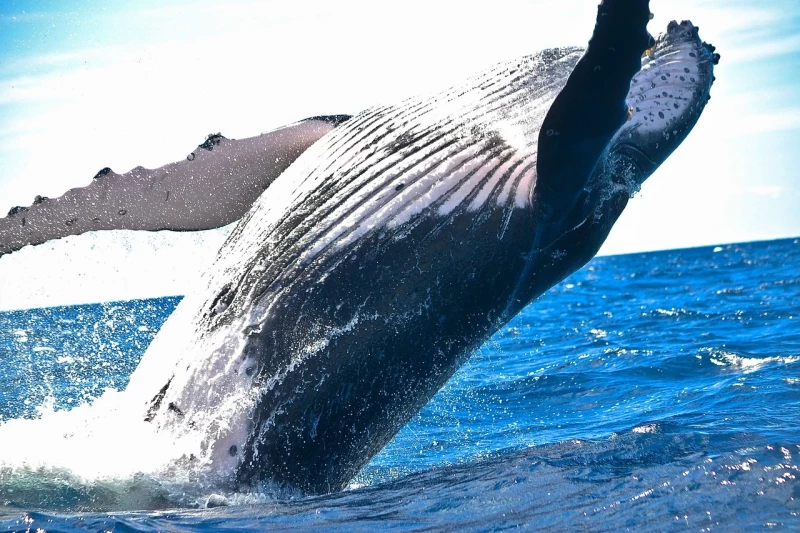
Whale watching in the Cook Islands is a captivating experience that provides the opportunity to witness these majestic creatures in their natural habitat. Here are some tips to make the most of this unique activity:
-
Whale Watching Season: Find out about the ideal season for whale watching in the Cook Islands. Typically, humpback whales migrate to these waters during the winter season, from July to October.
-
Choose a Whale-Watching Boat Tour: Opt for a boat tour specifically designed for whale watching. Local operators are familiar with the whale migration routes and can maximize your chances of spotting them.
-
Early Morning or Late Afternoon: Early mornings and late afternoons are often the best times for whale watching. The sea is usually calmer during these hours, providing optimal viewing conditions.
-
Listen to the Guide: If you have a guide or a whale-watching expert with you, pay close attention to their instructions. They can provide valuable information about whale behavior and ensure a respectful experience for these marine animals.
-
Bring Binoculars and a Camera: For a more detailed observation, bring binoculars. A camera with a good zoom capability can also help you capture memorable moments.
-
Wear Comfortable Clothing: Make sure to wear weather-appropriate clothing as sea conditions can change rapidly. Sun protection, sunglasses, and a hat are also recommended.
-
Respect the Distance: Adhere to rules and guidelines regarding the distance to be maintained from the whales. It's crucial to minimize disturbances for these wild animals.
-
Be Patient: Whale watching requires patience. Stay vigilant and keep an eye on the water surface for blows and tails, indicating the presence of whales.
-
Learn About Whale Species: Familiarize yourself with the different whale species you might encounter in the Cook Islands. This adds an educational aspect to your experience.
By following these tips, you'll maximize your chances of whale watching in the Cook Islands while contributing to the conservation of these incredible marine creatures.
Cook Islands - Where to Stay?
The Cook Islands offer a range of accommodation options to suit different budgets and traveler preferences. Most visitors choose to stay on the main island of Rarotonga, where the capital, Avarua, is located. Here are some suggestions for places to stay when visiting the Cook Islands:
-
Rarotonga:
-
Avarua: The capital has several accommodation options, from luxury hotels to more affordable guesthouses. You'll be close to amenities, restaurants, and activities.
-
Muri Beach: This area is known for its beautiful beaches and lagoon. You can find beachfront resorts, villas, and accommodation options.
-
Titikaveka: A peaceful region with beautiful beaches. You can find vacation rentals and small beachfront resorts.
-
-
Aitutaki:
- Aitutaki is another popular island for tourism, famous for its spectacular lagoon.
- Amuri Villas: An example of accommodation on Aitutaki, offering private beachfront villas.
-
Atiu:
- If you want to explore a less-visited island, Atiu can be an interesting option.
- Atiu Villas: Comfortable accommodation on this island, providing an opportunity to experience local culture.
-
Mauke:
- Another less-visited island, ideal for those seeking tranquility.
- Mauke Lodge: An example of accommodation offering an authentic experience.
-
Penrhyn:
- The northernmost island of the Cook Islands, suitable for those looking for isolation.
- Mama's Place: Accommodation option on Penrhyn.
Make sure to book your accommodation in advance, taking into consideration your personal preferences and budget. Whether you choose a luxury resort, a guesthouse, a vacation rental, or a more authentic experience in local establishments, you'll find a variety of options to make your stay in the Cook Islands memorable.
Cook Islands - How to get around?
Getting around the Cook Islands can be done in various ways, depending on the island you're visiting and your travel preferences. Here are some transportation options in the Cook Islands:
-
Car and Scooter Rentals: On the main island of Rarotonga, renting cars and scooters is a popular option for visitors who want to explore the island independently. Roads are generally well-maintained, providing complete flexibility to visit places at your own pace.
-
Bus: Rarotonga has a bus network that circles the island. Buses are an affordable option for getting around and are used by both locals and tourists. However, schedules may sometimes be limited.
-
Bicycles: Bicycle rentals offer an eco-friendly option for exploring Rarotonga. The flat terrain and relaxed pace of the island make cycling an enjoyable means of transportation.
-
Taxis: Taxis are available on Rarotonga and provide a more comfortable option for those who prefer not to drive themselves. They are also available for airport transfers.
-
Boat Transfers: If you are traveling to other islands, you may need to take a boat. Ferry services or small planes may be available depending on the island you plan to visit.
-
Domestic Flights: To move between different islands, you can also take domestic flights. Air Rarotonga is the main domestic airline serving multiple islands.
It's important to note that the transportation infrastructure may vary from one island to another, with more limited options on less frequented islands. It's recommended to plan your transportation in advance based on your itinerary and planned activities. Some islands may also lend themselves to walking, especially if you're exploring smaller and less developed areas.
Cook Islands - Best period
The Cook Islands can be visited year-round due to their tropical climate. However, it's important to note the seasonal variations and choose the period that best suits your preferences in terms of climate and activities. Here are some considerations for each season:
-
High Season (November to March):
- Climate: The months from November to March correspond to the hot and humid season. Temperatures are higher, with possible showers. It's also the season for tropical cyclones, although the Cook Islands are generally less affected than some other Pacific regions.
- Activities: Water sports, snorkeling, and scuba diving are popular during this period. Beaches are lively, but accommodation may be more expensive.
-
Low Season (April to October):
- Climate: The dry season extends from April to October, with pleasant temperatures and less humidity. This is generally considered the best time to visit due to stable weather conditions.
- Activities: The low season is ideal for hiking, exploring the islands, and relaxing on the beaches. Accommodation rates may be more affordable.
-
Special Events:
- Tiare Festival (November): Celebration of the Cook Islands' iconic flower with dances, music, and competitions.
- Te Maeva Nui (July/August): National celebration with parades, concerts, and cultural events.
It's always recommended to check the specific weather conditions for the period of your travel and plan accordingly. The low season typically offers milder weather conditions and a more peaceful experience, while the high season is conducive to water activities and cultural festivities.
